Citroen C5 2017 (RD/TD) / 2.G Owner's Manual
Manufacturer: CITROEN, Model Year: 2017, Model line: C5, Model: Citroen C5 2017 (RD/TD) / 2.GPages: 348, PDF Size: 10.72 MB
Page 101 of 348
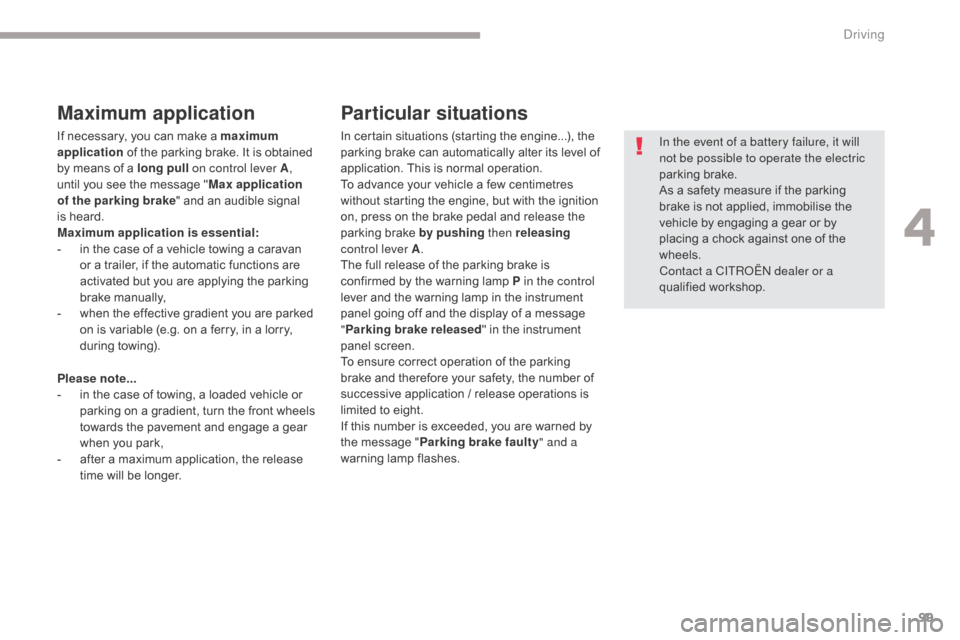
99
C5_en_Chap04_conduite_ed01-2016
Maximum application
If necessary, you can make a maximum
application of the parking brake. It is obtained
by means of a long pull on control lever A,
until you see the message " Max application
of the parking brake" and an audible signal
is heard.
Maximum application is essential:
-
i
n the case of a vehicle towing a caravan
or a trailer, if the automatic functions are
activated but you are applying the parking
brake manually,
-
w
hen the effective gradient you are parked
on is variable (e.g. on a ferry, in a lorry,
during towing).
Particular situations
In certain situations (starting the engine...), the
parking brake can automatically alter its level of
application. This is normal operation.
To advance your vehicle a few centimetres
without starting the engine, but with the ignition
on, press on the brake pedal and release the
parking brake by pushing then releasing
control lever A .
The full release of the parking brake is
confirmed by the warning lamp P in the control
lever and the warning lamp in the instrument
panel going off and the display of a message
" Parking brake released" in the instrument
panel screen.
To ensure correct operation of the parking
brake and therefore your safety, the number of
successive application / release operations is
limited to eight.
If this number is exceeded, you are warned by
the message " Parking brake faulty " and a
warning lamp flashes. In the event of a battery failure, it will
not be possible to operate the electric
parking brake.
As a safety measure if the parking
brake is not applied, immobilise the
vehicle by engaging a gear or by
placing a chock against one of the
wheels.
Contact a CITROËN dealer or a
qualified workshop.
Please note...
-
i
n the case of towing, a loaded vehicle or
parking on a gradient, turn the front wheels
towards the pavement and engage a gear
when you park,
-
a
fter a maximum application, the release
time will be longer.
4
Driving
Page 102 of 348
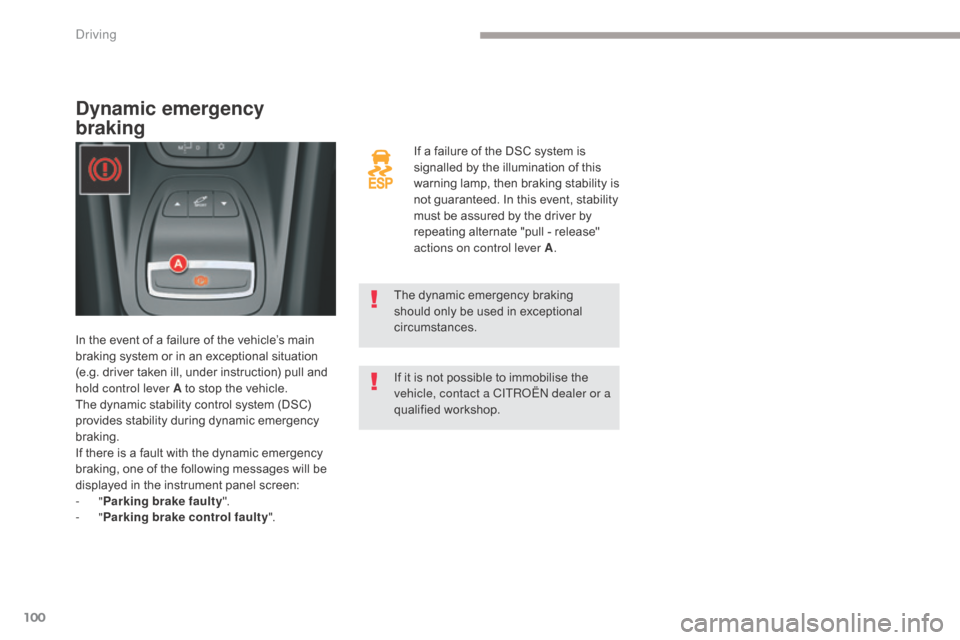
100
C5_en_Chap04_conduite_ed01-2016
If a failure of the DSC system is
signalled by the illumination of this
warning lamp, then braking stability is
not guaranteed. In this event, stability
must be assured by the driver by
repeating alternate "pull - release"
actions on control lever A.
The dynamic emergency braking
should only be used in exceptional
circumstances.
If it is not possible to immobilise the
vehicle, contact a CITROËN dealer or a
qualified workshop.
Dynamic emergency
braking
In the event of a failure of the vehicle’s main
braking system or in an exceptional situation
(e.g. driver taken ill, under instruction) pull and
hold control lever A to stop the vehicle.
The dynamic stability control system (DSC)
provides stability during dynamic emergency
braking.
If there is a fault with the dynamic emergency
braking, one of the following messages will be
displayed in the instrument panel screen:
-
"Parking brake faulty ".
-
"Parking brake control faulty ".
Driving
Page 103 of 348
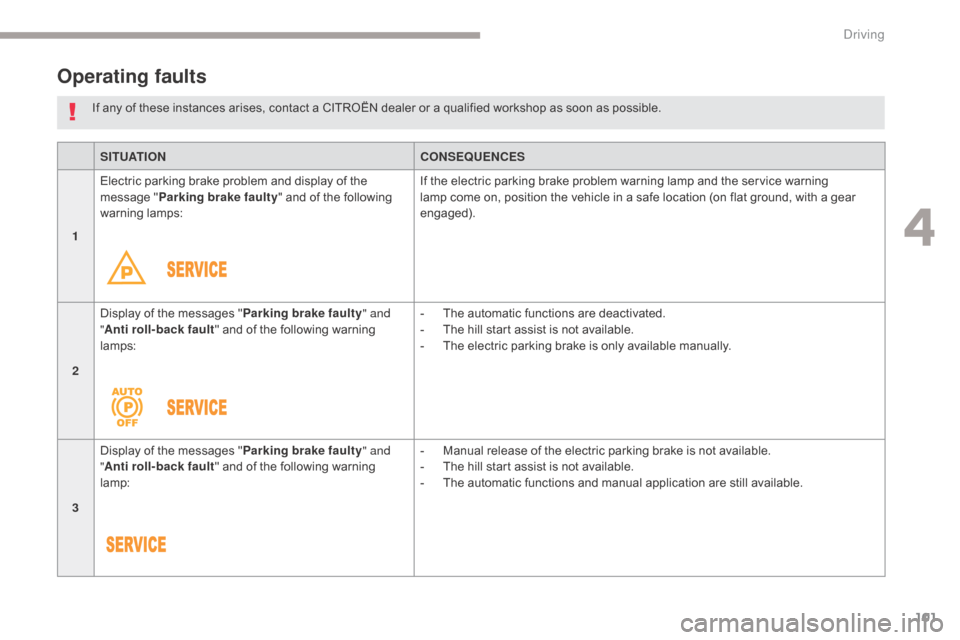
101
C5_en_Chap04_conduite_ed01-2016
SITUATIONCONSEQUENCES
1 Electric parking brake problem and display of the
message "
Parking brake faulty " and of the following
warning lamps: If the electric parking brake problem warning lamp and the service warning
lamp come on, position the vehicle in a safe location (on flat ground, with a gear
engaged).
2 Display of the messages "
Parking brake faulty" and
" Anti roll-back fault" and of the following warning
lamps: -
T
he automatic functions are deactivated.
-
T
he hill start assist is not available.
-
T
he electric parking brake is only available manually.
3 Display of the messages "
Parking brake faulty" and
" Anti roll-back fault" and of the following warning
lamp: -
M
anual release of the electric parking brake is not available.
-
T
he hill start assist is not available.
-
T
he automatic functions and manual application are still available.
If any of these instances arises, contact a CITROËN dealer or a qualified workshop as soon as possible.
Operating faults
4
Driving
Page 104 of 348
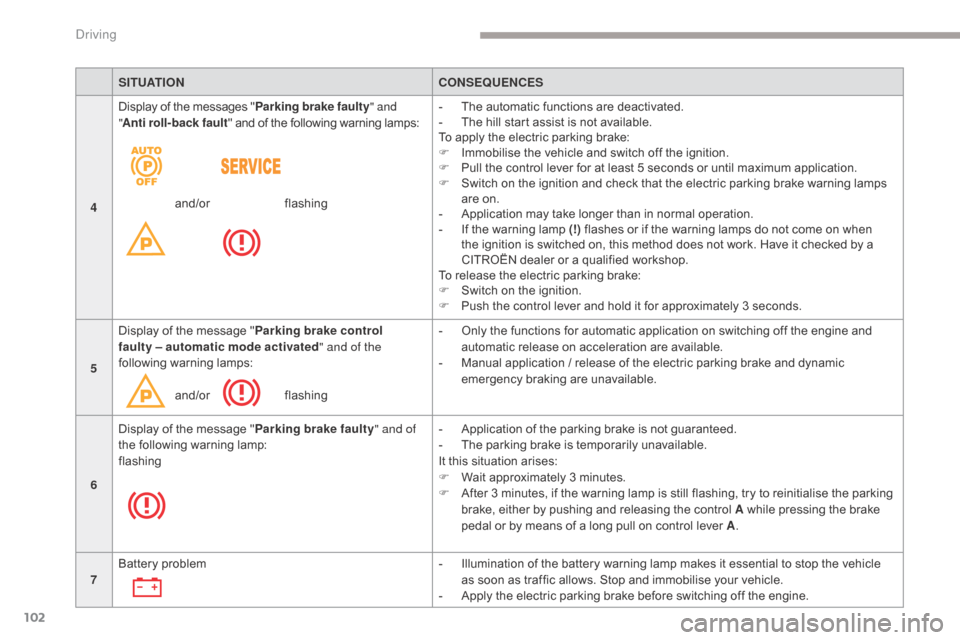
102
C5_en_Chap04_conduite_ed01-2016
SITUATIONCONSEQUENCES
4 Display of the messages "
Parking brake faulty" and
" Anti roll-back fault " and of the following warning lamps:
and/or
f
lashing-
T
he automatic functions are deactivated.
-
T
he hill start assist is not available.
To apply the electric parking brake:
F
I
mmobilise the vehicle and switch off the ignition.
F
P
ull the control lever for at least 5 seconds or until maximum application.
F
S
witch on the ignition and check that the electric parking brake warning lamps
are on.
-
A
pplication may take longer than in normal operation.
-
I
f the warning lamp (!) flashes or if the warning lamps do not come on when
the ignition is switched on, this method does not work. Have it checked by a
CITROËN dealer or a qualified workshop.
To release the electric parking brake:
F
S
witch on the ignition.
F
P
ush the control lever and hold it for approximately 3 seconds.
5 Display of the message "
Parking brake control
faulty
– automatic mode activated " and of the
following warning lamps:
and/or
f
lashing-
O
nly the functions for automatic application on switching off the engine and
automatic release on acceleration are available.
-
M
anual application / release of the electric parking brake and dynamic
emergency braking are unavailable.
6 Display of the message "
Parking brake faulty" and of
the following warning lamp:
flashing -
A
pplication of the parking brake is not guaranteed.
-
T
he parking brake is temporarily unavailable.
It this situation arises:
F
W
ait approximately 3 minutes.
F
A
fter 3 minutes, if the warning lamp is still flashing, try to reinitialise the parking
brake, either by pushing and releasing the control A while pressing the brake
pedal or by means of a long pull on control lever A .
7 Battery problem
-
I
llumination of the battery warning lamp makes it essential to stop the vehicle
as soon as traffic allows. Stop and immobilise your vehicle.
-
A
pply the electric parking brake before switching off the engine.
Driving
Page 105 of 348
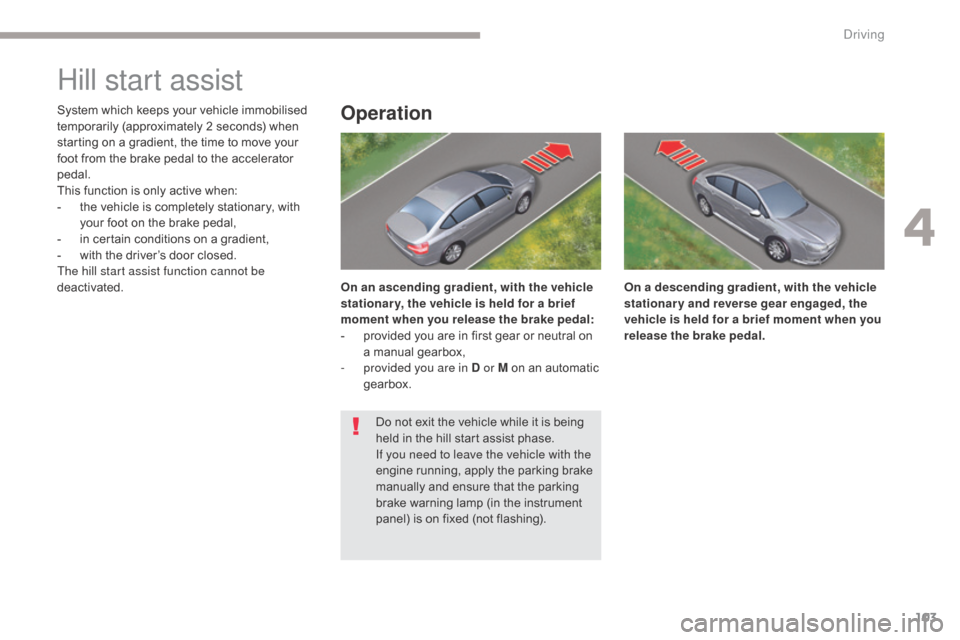
103
C5_en_Chap04_conduite_ed01-2016
Hill start assist
System which keeps your vehicle immobilised
temporarily (approximately 2 seconds) when
starting on a gradient, the time to move your
foot from the brake pedal to the accelerator
pedal.
This function is only active when:
-
t
he vehicle is completely stationary, with
your foot on the brake pedal,
-
i
n certain conditions on a gradient,
-
w
ith the driver’s door closed.
The hill start assist function cannot be
deactivated.Operation
On an ascending gradient, with the vehicle
stationar y, the vehicle is held for a brief
moment when you release the brake pedal:
-
p
rovided you are in first gear or neutral on
a manual gearbox,
-
p
rovided you are in D or M on an automatic
gearbox. On a descending gradient, with the vehicle
stationary and reverse gear engaged, the
vehicle is held for a brief moment when you
release the brake pedal.
Do not exit the vehicle while it is being
held in the hill start assist phase.
If you need to leave the vehicle with the
engine running, apply the parking brake
manually and ensure that the parking
brake warning lamp (in the instrument
panel) is on fixed (not flashing).
4
Driving
Page 106 of 348
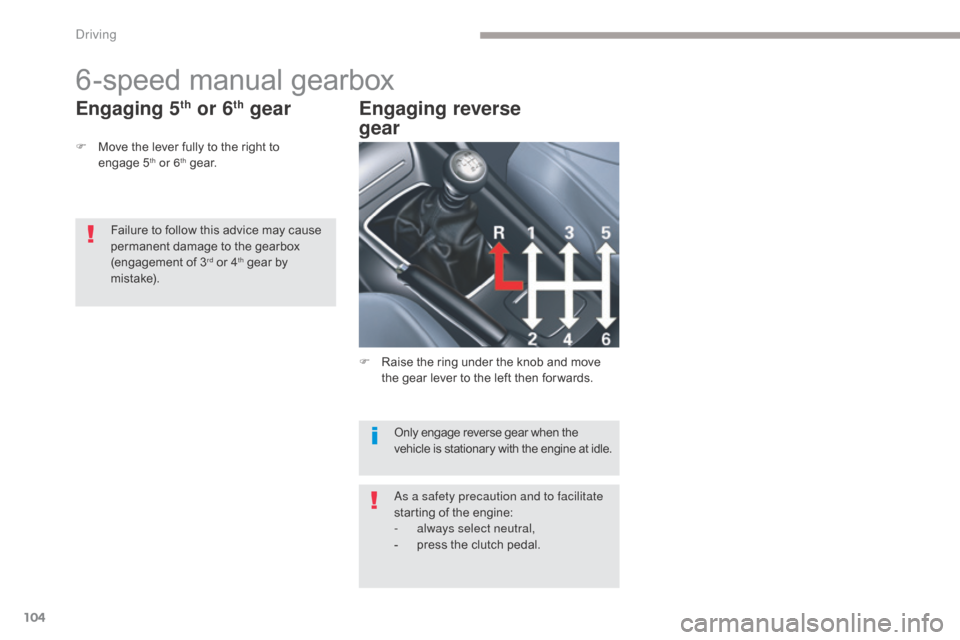
104
C5_en_Chap04_conduite_ed01-2016
6-speed manual gearbox
F Move the lever fully to the right to engage 5th or 6th g e a r.
Engaging 5th or 6th gear Engaging reverse
gear
Only engage reverse gear when the
vehicle is stationary with the engine at idle.
Failure to follow this advice may cause
permanent damage to the gearbox
(engagement of 3
rd or 4th gear by
m i st a ke).
F
R
aise the ring under the knob and move
the gear lever to the left then for wards.
As a safety precaution and to facilitate
starting of the engine:
-
a
lways select neutral,
-
p
ress the clutch pedal.
Driving
Page 107 of 348
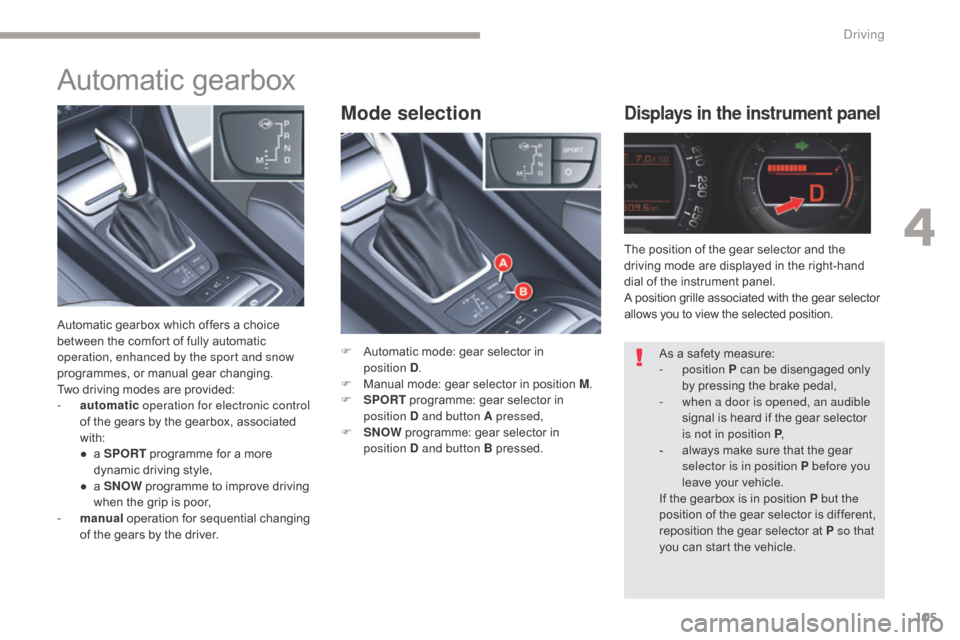
105
C5_en_Chap04_conduite_ed01-2016
Mode selectionDisplays in the instrument panel
F Automatic mode: gear selector in position D.
F
M
anual mode: gear selector in position M .
F
S
PORT programme: gear selector in
position D and button A pressed,
F
S
NOW programme: gear selector in
position D and button B pressed. The position of the gear selector and the
driving mode are displayed in the right-hand
dial of the instrument panel.
A position grille associated with the gear selector
allows you to view the selected position.
Automatic gearbox
Automatic gearbox which offers a choice
between the comfort of fully automatic
operation, enhanced by the sport and snow
programmes, or manual gear changing.
Two driving modes are provided:
-
a
utomatic operation for electronic control
of the gears by the gearbox, associated
with:
●
a
SPORT programme for a more
dynamic driving style,
●
a
SNOW programme to improve driving
when the grip is poor,
-
m
anual operation for sequential changing
of the gears by the driver. As a safety measure:
-
position P can be disengaged only
by pressing the brake pedal,
-
w
hen a door is opened, an audible
signal is heard if the gear selector
is not in position P ,
-
a
lways make sure that the gear
selector is in position P before you
leave your vehicle.
If the gearbox is in position P but the
position of the gear selector is different,
reposition the gear selector at P so that
you can start the vehicle.
4
Driving
Page 108 of 348

106
C5_en_Chap04_conduite_ed01-2016
Moving off
F To start the engine, the gear selector must be in position P or N .
F
O
perate the starter.
F
W
hen the engine is running, place the gear
selector at R , D or M.
F
C
heck in the instrument panel, the position
engaged.
F
R
elease the brake pedal and accelerate.
F
T
o avoid a possible difference between the
position of the gear selector and the actual
position of the gearbox, always come out
of position P with the ignition on and brake
pedal applied.
Otherwise, when the ignition is on or the engine
is running:
F
r
eposition the gear selector at position P ,
F
p
ut your foot on the brake pedal and then
select the gear you want.
Park
This position of the gear selector
is used to prevent the vehicle from
moving when you are stationary.
Reverse gear
Only engage this position when the
vehicle is stationary. To prevent
snatching, do not accelerate too soon
after selection.
Neutral
Never select position N if the vehicle
is moving.
F
T
o select position P
, move the gear selector
back to the highest position (towards R ),
then push it for wards and then to the left.
F
T
o exit position
P, move the gear selector to
the right and then to the position you want.
F
O
nly engage this position when the vehicle
is completely stationary. In this position,
the front wheels are locked. Make sure that
the gear selector is correctly positioned.
Never select position P or R if the
vehicle is not stationary.
If, while the vehicle is moving,
position
N is engaged inadvertently,
allow the engine to idle before engaging
position D or M .
Driving
Page 109 of 348
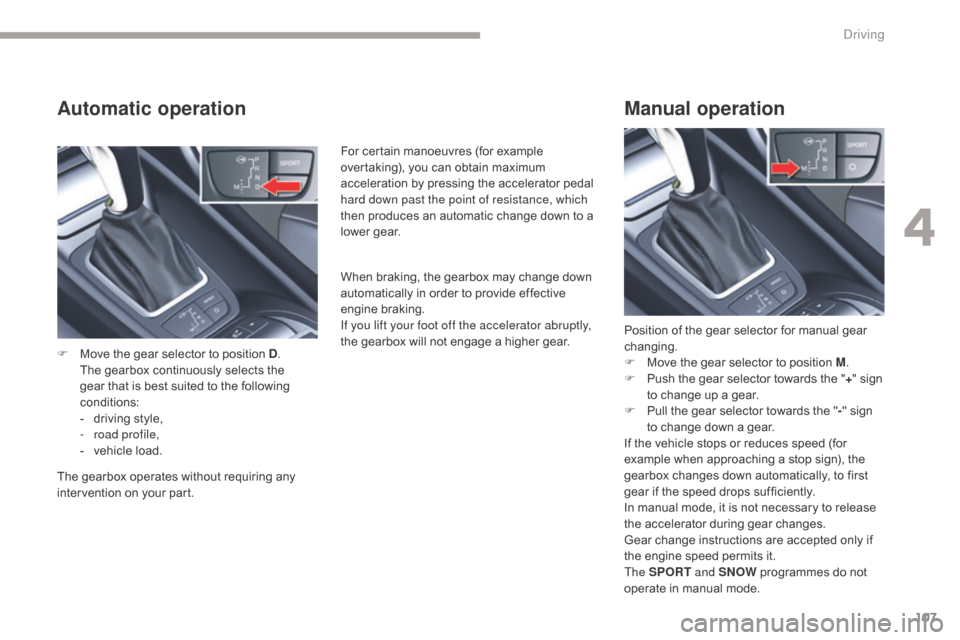
107
C5_en_Chap04_conduite_ed01-2016
Automatic operation
F Move the gear selector to position D. T
he gearbox continuously selects the
gear that is best suited to the following
conditions:
-
d
riving style,
-
ro
ad profile,
-
v
ehicle load. When braking, the gearbox may change down
automatically in order to provide effective
engine braking.
If you lift your foot off the accelerator abruptly,
the gearbox will not engage a higher gear.
Manual operation
Position of the gear selector for manual gear
changing.
F
M
ove the gear selector to position M .
F
P
ush the gear selector towards the " +" sign
to change up a gear.
F
P
ull the gear selector towards the " -" sign
to change down a gear.
If the vehicle stops or reduces speed (for
example when approaching a stop sign), the
gearbox changes down automatically, to first
gear if the speed drops sufficiently.
In manual mode, it is not necessary to release
the accelerator during gear changes.
Gear change instructions are accepted only if
the engine speed permits it.
The SPORT and SNOW programmes do not
operate in manual mode.
For certain manoeuvres (for example
overtaking), you can obtain maximum
acceleration by pressing the accelerator pedal
hard down past the point of resistance, which
then produces an automatic change down to a
lower gear.
The gearbox operates without requiring any
intervention on your part.
4
Driving
Page 110 of 348
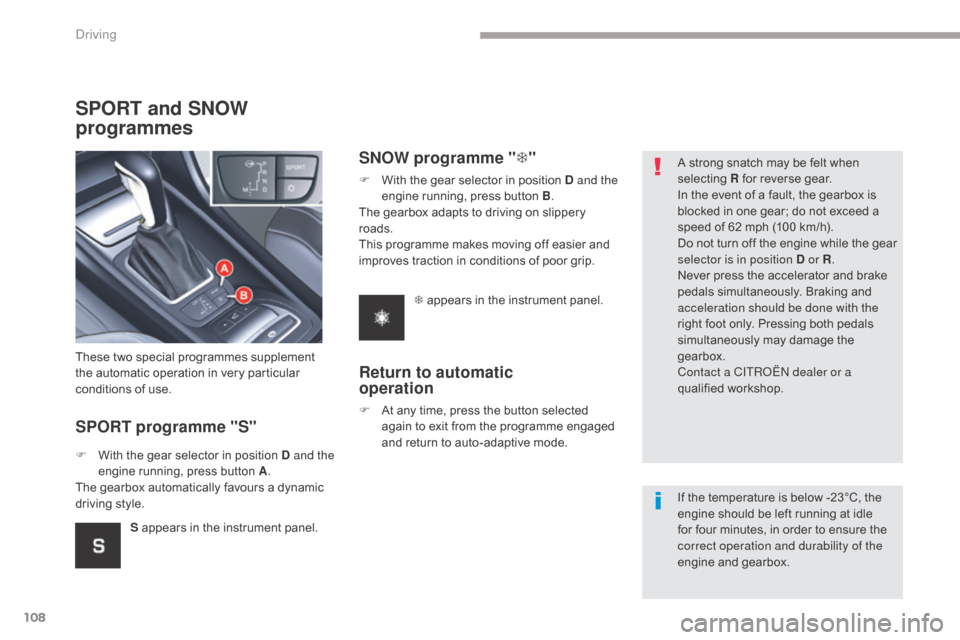
108
C5_en_Chap04_conduite_ed01-2016
SPORT and SNOW
programmes
SPORT programme "S"
These two special programmes supplement
the automatic operation in very particular
conditions of use.
F
W
ith the gear selector in position D and the
engine running, press button A .
The gearbox automatically favours a dynamic
driving style.
SNOW programme " T"
F With the gear selector in position D and the
engine running, press button B .
The gearbox adapts to driving on slippery
roads.
This programme makes moving off easier and
improves traction in conditions of poor grip.
T appears in the instrument panel.
S appears in the instrument panel.
Return to automatic
operation
F At any time, press the button selected again to exit from the programme engaged
and return to auto-adaptive mode. A strong snatch may be felt when
selecting
R for reverse gear.
In the event of a fault, the gearbox is
blocked in one gear; do not exceed a
speed of 62 mph (100 km/h).
Do not turn off the engine while the gear
selector is in position D or R .
Never press the accelerator and brake
pedals simultaneously. Braking and
acceleration should be done with the
right foot only. Pressing both pedals
simultaneously may damage the
gearbox.
Contact a CITROËN dealer or a
qualified workshop.
If the temperature is below -23°C, the
engine should be left running at idle
for four minutes, in order to ensure the
correct operation and durability of the
engine and gearbox.
Driving